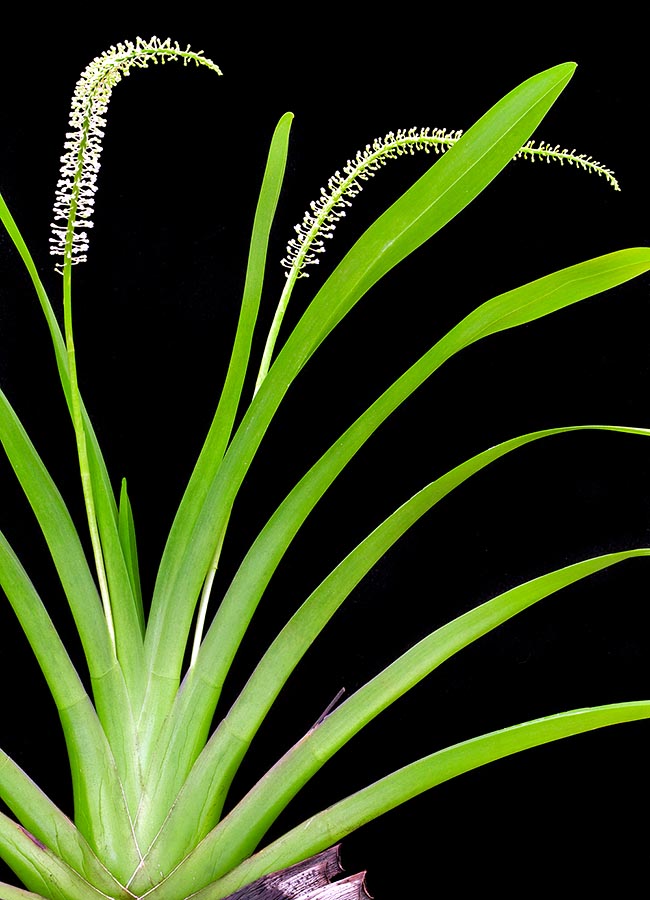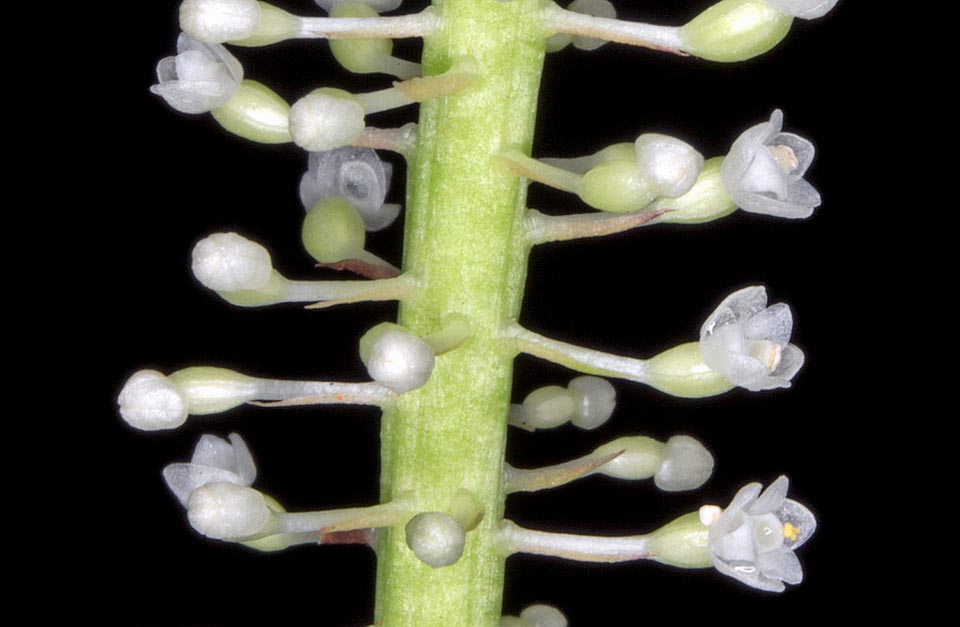Family : Orchidaceae

Text © Pietro Puccio

English translation by Mario Beltramini

The Phreatia micrantha is a epiphyte species, at times lithophyte, native to Oceania © Giuseppe Mazza
The species is native to Australia (Queensland), Bismarck Archipelago, Fiji, Mariana Islands, New Caledonia, New Guinea, Niue, Salomon Islands, Santa Cruz Islands, Tonga, Vanuatu and Wallis and Futuna where it lives on the trees, or less frequently, on the rocks of the humid forests, often on the edges of waterways, from the sea level up to about 2500 m of altitude.
The name of the genus is the Greek substantive “φρέαρ, φρέατος” (phréar, phréatos) = well, with possible reference to the sack-like spur (mentum) formed by the lateral sepals; the specific name is the combination of the Greek adjective “μικρός” (mikrós) = small and of the substantive “ἄνθος” (anthos) = flower, with obvious reference.
Common names: native fan orchid (Australia).
The Phreatia micrantha (A.Rich.) Lindl. (1859) is an epiphyte or at times lithophyte species with short rhizome and filiform roots, with 5-10 alternate, distichous leaves, erect or arcuate, linear with irregularly bilobate obtuse apex, 10-35 cm long and 1,2-2,5 cm broad, coriaceous, of intense green colour, and imbricate foliar bases, 4-5 cm long, that conceal the short stem.
Racemose axillar inflorescences, 12-30 cm long, erect or curved, carrying several tiny close flowers, of 2-3 mm of diameter, white; pedicel and 3-4 mm long clavate ovary. Free ovate sepals with acute or obtuse apex, 1,5 mm long, the lateral ones united at the base of the column, free petals obliquely ovate, about 1 mm long, subrhomboidal labellum with obtuse apex, about 1,5 mm long and 1 mm broad and about 1 mm long column. It reproduces by seed, in vitro, but usually at amateur level, by division.
Species with the characteristic fan shape widely diffused in nature, but rare in cultivation, requires a semi-shady position, cool to warm temperatures, with lowest winter night ones not less than 15 °C, high humidity, 70-85 %, and constant movement of the air. It can be cultivated in pot utilizing a draining and aerated substratum that can be formed by finely cut fragments of bark and charcoal with addition of sphagnum, or mounted on branches, pieces of bark, rafts of cork or of roots of arborescent ferns with sphagnum at the base, to maintain the humidity to the thin roots. Regular watering, but without stagnations to avoid root rottenness, utilizing rainwater, de-mineralized or by reverse osmosis.
The species is inscribed in the appendix II of the CITES (species whose trade is internationally ruled).

Frequent in nature but rare in cultivation, is characteristically fan-shaped. 12-30 cm inflorescences with several tiny close flowers, of 2-3 mm of diameter © Giuseppe Mazza
Synonyms: Oberonia micrantha A.Rich. (1834); Eria richardiana Rchb.f. (1868); Eria sphaerocarpa Rchb.f. (1868); Thelasis samoensis Kraenzl. (1898); Oberonia papuana F.M.Bailey (1900); Phreatia macrophylla Schltr. (1906); Phreatia samoensis (Kraenzl.) Schltr. (1907); Phreatia graeffei Kraenzl. (1911); Phreatia louisiadum Kraenzl. (1911); Phreatia richardiana (Rchb.f.) Kraenzl. (1911); Phreatia sarcothece Schltr. (1911); Phreatia collina Schltr. (1913); Phreatia collina var. linearis Schltr. (1913); Phreatia moluccana J.J.Sm. (1914); Phreatia macrophylloides Kraenzl. (1929); Phreatia robusta R.S.Rogersm (1930); Rhynchophreatia micrantha (A.Rich.) N.Hallé (1977); Phreatia clivicola W.Kittr. (1985); Rhipidorchis micrantha (A.Rich.) D.L.Jones & M.A.Clem. (2004).
